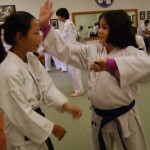Aikido Techniques and Children: It’s About Having Fun

Aikido Techniques: Children's Aikido (2)
In the movie Field of Dreams the central character, Ray Kinsella, talk about playing catch as a teenager with his dad as being like “eating vegetables”. When dealing with children, we do not want them to view Aikido techniques and training this way.
Video: Aikido Technique of Leading
We all know that the younger the child, the shorter the attention span. In fact, as a six year old my attention span was measured in microseconds. So how does one deal with this phenomenon is an effective manner? One of the keys is to do your best to make the training fun. Perhaps it is the idea of blindfolding a child hand have the others push on him from different directions and this blending exercise becomes one of “feeling” rather than focusing on repeating a kogegaeshi over and over again.
Teaching Aikido Techniques to Children: Vary the Routine
It can also involve the breaking up of some routines by creating an obstacle course that the children must negotiate through the execution of correct Aikido techniques such as doing a high break fall onto a crash pad, or the creation of a “bridge” composed of chairs and bokkens or jos that the child must negotiate using the Samurai Walk also known as Shikko. Strining several of these together can break up the monotony of training.
The Sempai-Kohai Relationship in Aikido Techniques
One can also utilize the concept of the Sempai-Kohai relationship to place a greater level of responsibility onto the shoulders of a the older students. This keeps the older students focused on mentoring the younger ones and keeps all of them engaged. In addition, creating a break in training through the use of a game that might dissipate pent up energy is also a way to keep the young Aikidoist from zoning out.
In summary, children don’t learn in the same way as adults and can not remain focused for as long on a specific Aikido technique. They also do not do well with monotony and repetition. Thus, they key to keeping children engaged is to find a way to help break monotony, and create fun.

Leave a Reply